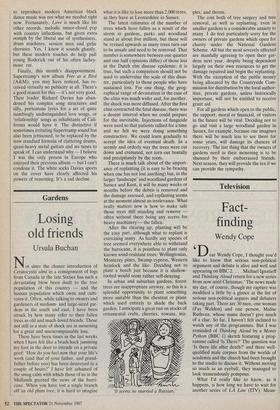Gardens
Losing old friends
Ursula Buchan
Not since the chance introduction of Ceratocystis ulmi in a consignment of logs from Canada in the late Sixties has such a devastating blow been dealt to the tree population of this country — and the human population which owns and culti- vates it. Often, while talking to owners and gardeners of medium- and large-sized gar- dens in the south and east, I have been struck by how many refer to their fallen trees as old and much-loved friends. Those not still in a state of shock are in mourning for a great and unencompassable loss.
There have been times in the last weeks when I have felt like a brash hack jamming my foot in the door to intrude on a private grief: 'How do you feel now that your life's work (and that of your father, and grand- father before you) has been destroyed in a couple of hours?' I have felt ashamed of the smug calm with which those of us in the Midlands greeted the news of the hurri- cane. When you have lost a single branch off an old plum tree, it is hard to imagine what it is like to lose more than 2,000 trees, as they have at Leonardslee in Sussex.
The latest estimates of the number of trees which have fallen as a result of the storm in gardens, parks and woodland stand at about five million, but these will be revised upwards as many trees turn out to be unsafe and need to be removed. That number is somewhere between one quarter and one half (opinions differ) of those lost in the Dutch elm disease epidemic, it is true, but such a comparison should not be used to undervalue the scale of this disas- ter, particularly to those people who have sustained loss. For one thing, the geog- raphical range of devastation in the case of the elms was much wider and, for another, the shock was more diffused. After the first elms contracted the fatal disease, there was a decent interval when we could prepare for the inevitable. Injections of fungicide were used so that patients rallied for a time and we felt we were doing something constructive. We could learn gradually to accept the idea of eventual death. In a seemly and orderly way the trees were cut down and cremated, not torn out brutally and precipitately by the roots.
There is much talk about of the import- ance of replanting (it is easy to be bracing when one has not lost anything) but, in the larger 'landscape' and woodland gardens of Sussex and Kent, it will be many weeks or months before the debris is removed and the damage assessed, and repranting seems at the moment almost an irrelevance. What really matters now is how to make safe those trees still standing and remove — often without there being any access for heavy machinery — the fallen. After the clearing up, planting will be the easy part, although what to replant is exercising many. As hardly any species of tree seemed everywhere able to withstand the hurricane, it is pointless to plant only known wind-resistant trees: Wellingtonias, Monterey pines, Swamp cypress, Western hemlock and the like. Deciding not to plant a beech just because it is shallow- rooted would seem rather self-denying.
In urban and suburban gardens, forest trees are inappropriate anyway, so this is a splendid opportunity to plant something more suitable than the chestnut or plane which used entirely to shade the back garden. I anticipate a great run on stocks of ornamental crabs, cherries, rowans, ma- 'It seems he married a Russian.' pies, and thorns.
The cost both of tree surgery and tree removal, as well as replanting, even in smaller gardens is a considerable anxiety to many. I do feel particularly sorry for the owners of private gardens which open for charity under the National Gardens Scheme. All but the most severely affected are manfully agreeing to open their gar- dens next year, despite being dependent largely on their own resources to get the damage repaired and begin the replanting. With the exception of the public money being allocated by the Countryside Com- mission for distribution by the local author- ities, private gardens, unless historically important, will not be entitled to receive grant aid.
For all gardens which open to the public, the support, moral or financial, of visitors in the future will be vital. Deciding not to go and visit a large woodland garden in Sussex, for example, because one imagines there will be much less to see there for some years, will damage its chances of recovery. The last thing that the owners of gardens need in their mourning is to be shunned by their embarrassed friends. Next season, they will provide the tea if we can provide the sympathy.


































































 Previous page
Previous page